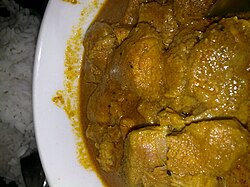 Pork vindaloo, served in a Goan-style Indian restaurant, 2006 | |
| Alternative names | Vindalho |
|---|---|
| Type | Curry |
| Course | Main course |
| Place of origin | India |
| Region or state | Goa |
| Main ingredients | Pork, vinegar, spices, chili peppers |
Vindaloo or vindalho is a curry dish known globally in its British-Indian form as a staple of curry houses and Indian restaurants, specifically a fiery, spicy dish. Vindaloo's name derives from the quite different Portuguese Goan dish carne de vinha d'alhos (meat with garlic vinegar). [1] [2] The Goan recipe is a mildly spiced pork dish, but alternative versions are commonly used, such as beef, chicken, lamb, mutton, prawns, vegetables and tofu. [3]


